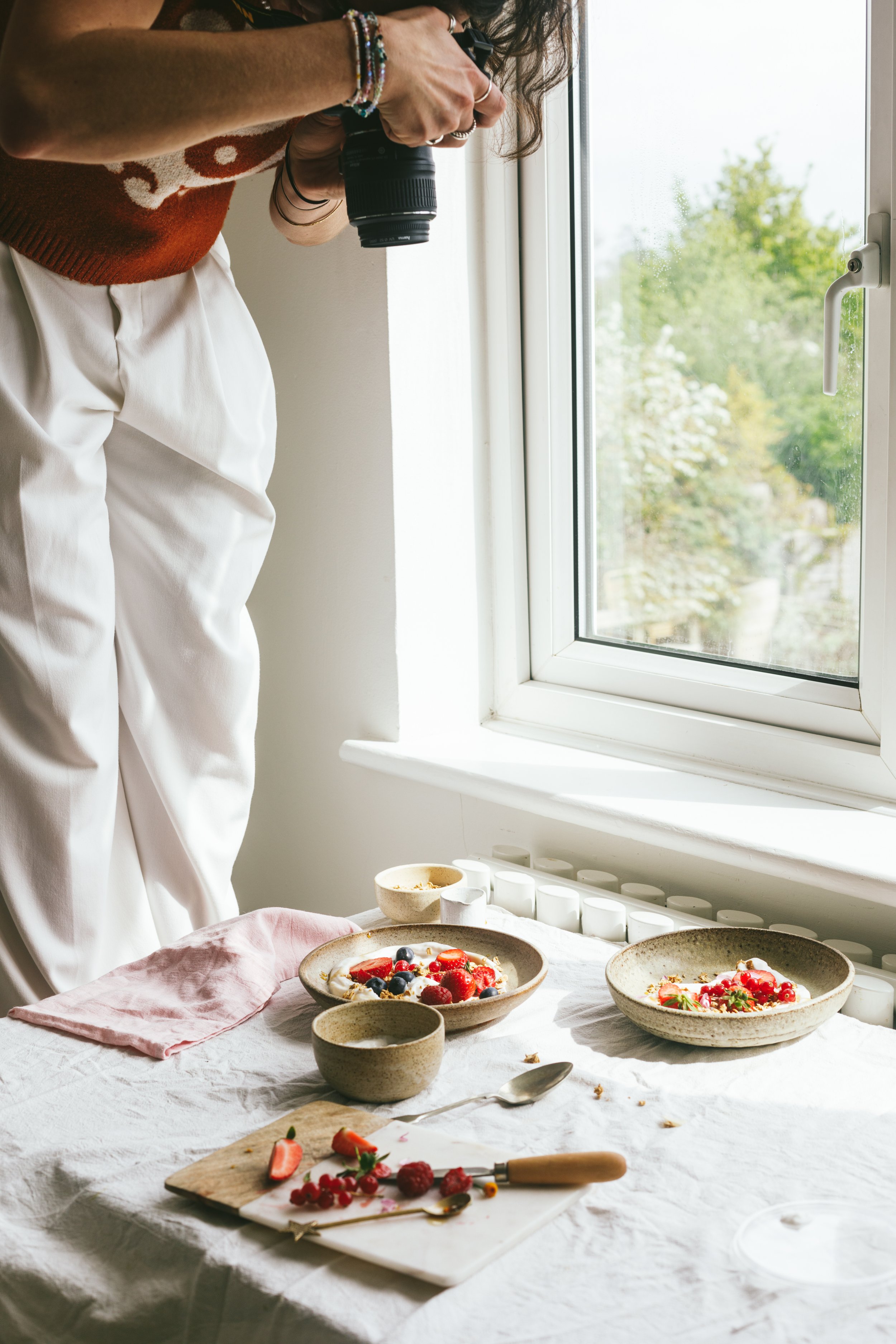ARTIFICIAL LIGHT OR NATURAL LIGHT, WHICH IS BEST FOR FOOD PHOTOGRAPHY?
The question whether natural light or artificial light is better for food photographers eager to create the most gorgeous food photos, is a difficult one to answer. While natural light is my preferred personal choice as it pulls most at my heart strings and holds undeniable charm for me, after a decade of professional experience as a food photographer, I’ve come to deeply appreciate and love the beauty, versatility and reliability of artificial light. It’s made me realise that lighting preferences are inherently personal, requiring thoughtful deliberation and deep consideration of each photographer’s individual and creative needs.
In this blog post I’ll highlight some key differences between the two lighting choices for food photographers, so you can ascertain whether natural light, artificial light or a blend of both, suits you best!
WHAT’S YOUR LIGHTING BUDGET?
The beauty of natural light is that it’s absolutely free! All you need is a window and you’re ready to photograph food to your heart’s content. Therefore, if you’re at the start of your food photography journey and unsure if this is a long term hobby/career choice, or merely a passing phase that doesn’t warrant big bucks spending, natural light is the way to go! Also, if you’re strapped for cash then nothing beats natural light!
Though artificial light set ups come in all shapes and sizes as well as different price tags, not a single option is free. Though a simple set up can cost as little as £50, most professional lighting will easily set you back several hundred pounds.
Winner: Natural light
how much control and consistency do you need as a FOOD photographer?
There’s no speckle of a doubt that you have more control and consistency when you use artificial light! You can choose the angle, the intensity and the level of diffusion you need. You’re also not dependent on the weather, but instead can plan for a specific creative look regardless of what time or season your photo shoot takes place.
This level of control and consistency makes artificial lighting the perfect choice when shooting commercial work, when shooting food products and/or when you have to maintain one specific lighting look and feel during a long day’s shoot!
If you’re shooting a personal project, if your photo shoot is for half a day only and/or you simply don’t need each and every shot to have the exact same lighting look, then perhaps control and consistency isn’t at the top of your agenda and natural light will therefore more than do!
There’s also something to be said for capturing more shots with changeable light. For example, if you’re shooting a breakfast recipe, it’s lovely to photograph it at the start of the day when sun rays enter your studio. In turn, it’s near to poetic to capture a dinner meal later in the day when natural light feels a little moodier; that way it more authentically and accurately reflects that cosier evening vibe!
Finally, I’d also argue that learning to get the most out of natural light by figuring out how to shape it, maximise it and truly understand it, is an important skill to hone as a food photographer. It takes time, patience and practice and can help you inch closer to that consistent look you get from working with artificial lighting!
Winner: Artificial Light
WHEN AND WHERE ARE YOU PHOTOGRAPHING FOOD?
Natural light is a wonderful option if you’re capturing lifestyle images, especially those set outdoors like picnics for example, if you’re capturing delicious food during travels, if you’re in a beautiful day light studio, a cramped and busy cafe with little space for bulky lighting gear or anywhere else that has at least one good window with access to natural light. Of course you do require the sun to make an appearance and hence shooting during the day is essential should you wish to use natural light! Furthermore, not all sunlight is created equal with lighting during darker winter months sometimes not quite potent enough to allow you to create the food photo you’re after. Hence, before planning what lighting you’re going to use, take the time of day, location and season into account!
Finally, the beauty of working with natural light is that it’s there and easily accessible, no matter where in the world you are! It therefore allows for the most spontaneous, candid captures imaginable.
As a restaurant photographer or someone who tends to mainly capture drinks in dark and moody bars, your best bet is undoubtedly artificial light! Of course you need to ensure that there’s space for your lights and diffusers, but if you need to capture an evening service at a bustling restaurant or the true ambience of a moody bar, then the inconvenience associated with taking up some space with your set up will be well worth it for your clients!
I’d also argue that if you’re shooting in a professional studio, it’s always a good idea to bring your lighting gear with you! More lighting options gives you more creative freedom and if you have the space, why not use it try to out different set ups throughout the day!
Lastly, if you’re capturing food during dark winter days, artificial lighting cannot be beaten!
Winner: It’s a tie as it greatly depends on the location and timing Of your food shoot!
WHAT ARE YOU PHOTOGRAPHING?
Personally, I love the look of harsh light when capturing cocktails. There’s just something about how the light interacts with the clear liquid and the glass that creates something so spectacular; it’s hard not to be totally captivated by it. PLUS, harsh light allows for THE most dramatic action shots such as splashes and pours. Therefore, I often turn to artificial light when photographing drinks (BTW, I live in cloudy London and have an east facing studio meaning my chances of harsh natural light are very slim).
As mentioned previously, packaging and food products tend to look their best when captured using artificial light, though this of course does depend a little on the look and feel you’re after.
In turn if I’m shooting images that require me to use hand models or photos that include a lot of lighter tones such as vanilla cake frosting, I much prefer using natural light. It’s gentler and somehow always strikes the right tone between highlights and shadows.
WINNER: It’s a tie as it greatly depends on what you’re photographing (and the look you’re after)
WHAT LOOK & FEEL ARE YOU AFTER IN YOUR FOOD PHOTOS?
Food photography is art and art is personal. Therefore, I’d argue that lighting choices are personal too. Natural light - assuming you have a decent sized window and are photographing your food on a day where there’s sufficient light - has something very romantic about it. It looks sensual and soothing and creates food photos that feel real and authentic. True, one can try and replicate this feeling with artificial light, but personally I can always tell when it’s artificial light.
Artificial light is more controlled and allows for endless creative opportunities, which can result in fun, experimental and also really beautiful food shots! It’s so trendy to use harsh flash right now and for good reason: what’s not to like?!
Whether one is better for you than the other therefore greatly depends on what type of food photos you wish to create, what type of food photography clients you want to speak to and what type of food photography makes your heart sing loudest.
WINNER: It’s a tie as it greatly depends on the look and feel you are after!
artificial lighting versus natural light or both?
Maybe it isn’t a matter of either or, but both! Being comfortable and confident capturing food photos using natural and artificial light will make you a more sought after and versatile food photographer. It will give you the most creative freedom possible and enable you to truly find a food photography style all of your own.
If you’re already a few years into your journey and you are confident that a specific way of capturing and lighting food is truly your calling, then go for it! But limiting yourself to one over the other prematurely can stop you from gaining the skills to deal with any lighting situation you encounter.
I’d also argue that the principles of good lighting apply regardless of whether you’re working with natural light or artificial light and therefore not even the most advanced and most expensive artificial light set up will render good results if you don’t know the key lighting principles.
Even though I wasn’t able to give you a definite answer as to which lighting is better than the other for food photography, I do hope this blog post has given you some food for thought!
Thanks for stopping by!
Before you go…
If you’re a food photographer who is eager to take the next step forward and build an irresistible food photography portfolio, be sure to download my FREE portfolio mini guide below!
Alternatively, do check out my food photography and styling workshops HERE, I’d love to hear from you.







